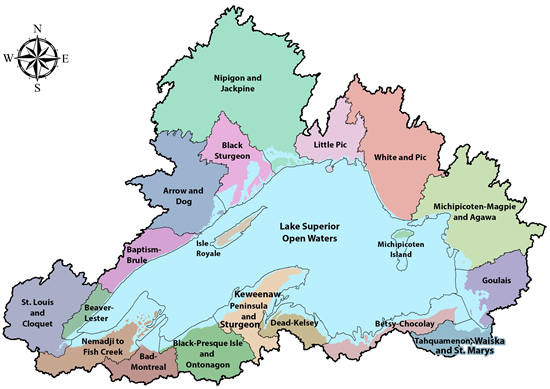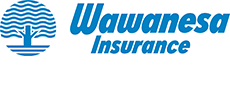Lake Superior Biodiversity Conservation Strategy
The Lake Superior Biodiversity Conservation Strategy was completed in February 2015. This strategy provides a summary of the health of and threats to the biodiversity of Lake Superior. It presents a guide to implementing effective lake-wide and regional conservation strategies.
This strategy contributes to the 2012 Great Lakes Water Quality Agreement commitment of developing lake-wide habitat and species protection and restoration conservation strategies.
Government agencies, local stakeholders, organizations and groups have all been instrumental in developing the Lake Superior Biodiversity Conservation Strategy. The information in the strategy is intended to help all parties to identify and apply necessary actions within Lake Superior's watersheds, coasts and waters.
A Biodiversity Conservation Assessment for Lake Superior, Volume 1: Lakewide Assessment (Updated March 2015) (8 MB) has been updated and re-released.
Regional Plans Released
Twenty corresponding regional plans that identify local and regional conservation opportunities have been completed and released. The conservation actions identified in the regional plans were developed with much input from local stakeholders. Together, the strategy and the regional plans will support taking action around Lake Superior. They will help with the overarching goal of protecting and restoring Lake Superior’s habitat and species.
To familiarize yourself with this initiative, we invite you to review the following presentation.

If you have comments or questions please contact:
greatlakes-grandslacs@ec.gc.ca (for the Canadian based regional units)
superiorplans@glnpo.net (for the U.S. based regional units)
Final Draft Biodiversity Conservation Assessment
Report Review Processes
Final Draft Conservation Assessment Reports
The Lake Superior Biodiversity Conservation Assessment is found in two reports. The first report is a lake-wide assessment of conditions and stressors, called A Biodiversity Conservation Assessment for Lake Superior. The second report is a regional assessment of conditions and stressors, called Regional Unit Summaries.
- A Biodiversity Conservation Assessment for Lake Superior, Volume 1: Lakewide Assessment (Updated March 2015) (8 MB) has been updated and re-released.
- Notice from Co-Chairs of Superior Work Group (263 KB)
- A Biodiversity Conservation Assessment for Lake Superior, Volume 2: Regional Unit Summaries (Updated September 2015) (6 MB)
This work was initiated and managed by the Superior Work Group of the Binational Program to Restore and Protect Lake Superior (which is responsible for preparing and implementing a Lakewide Action and Management Plan). Coordination was provided by the Nature Conservancy of Canada.
The Assessment is the first in the Great Lakes to use watershed, coastal zone and water indices in the evaluation of major habitat types. This work was possible because of the science and information available from a number of major initiatives. This includes:
- the Great Lakes indicators available through the State of the Lakes Ecosystem Conference process
- the Great Lakes Environmental Indicators project
- the Great Lakes Environmental Assessment and Mapping project, and
- the coastal condition index developed by The Nature Conservancy and the Nature Conservancy of Canada
Background
Lake Superior is unique among the world’s 253 large freshwater lakes. Situated at the top of the chain of the Great Lakes, it is the world’s largest freshwater lake. It holds more water than all the other Great Lakes combined. It is also a lake of extraordinary biodiversity. Superior contains endemic fishes, including a unique deepwater form of lake trout. Its cool coastlines and islands harbour arctic-alpine plants and woodland caribou. Lake Superior is also a region of growing threats.
In the fall of 2012, the Superior Work Group of the Lake Superior Lakewide Action and Management Plan (LAMP) initiated a Biodiversity Conservation Assessment for Lake Superior. This project supports implementation of the Great Lakes Water Quality Agreement (GLWQA). It contributes to the GLWQA Annex 7 commitment to “complete the development and begin implementation of lakewide habitat and species protection and restoration conservation strategies…”
The project is building from a strong history of conservation action and information around Lake Superior, including the LAMP’s Ecosystem Goals and the Great Lakes Fishery Commission's Fish Community Objectives.
Objectives
The Biodiversity Conservation Assessment provides the scientific basis for the Biodiversity Conservation Strategy. The final Lake Superior Biodiversity Conservation Strategy is similar to projects that have been completed for the other four Great Lakes.
With the input of many partner organizations and Lake Superior experts, and funding from Environment Canada, the Nature Conservancy of Canada is coordinating the development of the Lake Superior Biodiversity Conservation Assessment and the Lake Superior Biodiversity Conservation Strategy.
Project scope
The project scope is the biodiversity of the waters of Lake Superior, as well as coastal areas, tributaries and watersheds (with a focus on how they affect the biodiversity of the waters of Lake Superior). See map [PDF 1.6MB].
Project steering committee
Representatives of the LAMP Superior Work Group from the following organizations participate on the project’s steering committee:
- 1854 Treaty Authority
- Environment Canada
- Great Lakes Indian Fish and Wildlife Commission
- Michigan Department of Environmental Quality
- Minnesota Department of Natural Resources
- National Park Service
- Ontario Ministry of Natural Resources
- Parks Canada
- USDA Forest Service
- USDA Natural Resources Conservation Service
- U.S. Environmental Protection Agency
- Wisconsin Department of Natural Resources
Report review process
A draft version of the Lake Superior Biodiversity Conservation Assessment report was circulated to the Lake Superior expert list in late February 2013 for review. The Lake Superior expert list also received an invitation to participate in a series of webinars. These provided an opportunity to discuss the report with others, ask questions and provide input.
The Lake Superior Biodiversity Conservation Strategy underwent a similar review process. A series of introductory webinars was held, followed by periods of regional engagement and input. Both the lake-wide Biodiversity Conservation Strategy and the 20 regional plans were subject to open review. The input received was used to refine the strategy and plans.
Contact
Please feel free to contact any of the project steering committee members named in the reports if you have any questions.
Draft documents
Click to open in new window or right-click to save.
- Lake Superior Biodiversity Conservation Assessment Project Sheet [PDF 470KB]
- Lake Superior Biodiversity Conservation Assessment Introductory Webinar Presentation [PDF 1.6MB]
- Lake Superior Experts Distribution List [PDF 309KB]
- Lake Superior Biodiversity Conservation Assessment Draft Report [PDF 5.8MB]
- Lake Superior Regional Unit Summaries Draft Report [PDF 11MB]
- Lake Superior Biodiversity Conservation Assessment Report Review Form [DOC 43KB]
- Project scope map [PDF 1.6MB]





